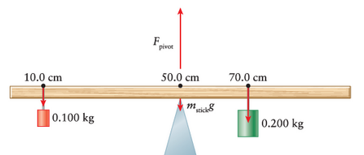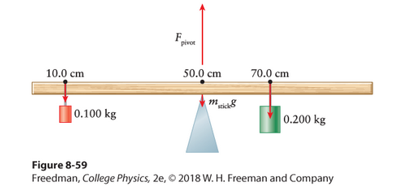
Clockwise and counter-clockwise torques acting on the board due to the four forces shown about an axis pointing out of the page at the
Answer to Problem 101QAP
Clockwise torque=
Counter-clockwise torquey1
Explanation of Solution
Given:

Formula used:
Torque can be interpreted as,
Calculation:
Consider the clockwise torque,
Consider the vertical forces of the system,
Consider the counter-clockwise torque,
Conclusion:
Clockwise and counter-clockwise torques acting on the board due to the four forces shown about an axis pointing out of the page at the
Clockwise and counter-clockwise torques acting on the board due to the four forces shown about an axis pointing out of the page at the
Answer to Problem 101QAP
Clockwise torque=
Counter-clockwise torque=
Explanation of Solution
Given:

Formula used:
Torque can be interpreted as,
Calculation:
Consider the clockwise torque,
Consider the counter-clockwise torque,
Conclusion:
Clockwise and counter-clockwise torques acting on the board due to the four forces shown about an axis pointing out of the page at the
Clockwise and counter-clockwise torques acting on the board due to the four forces shown about an axis pointing out of the page at the
Answer to Problem 101QAP
Clockwise torque=
Counter-clockwise torque=
Explanation of Solution
Given:

Formula used:
Torque can be interpreted as,
Calculation:
Consider the clockwise torque,
Consider the counter-clockwise torque,
Conclusion:
Clockwise and counter-clockwise torques acting on the board due to the four forces shown about an axis pointing out of the page at the
Verify the stability of the stick after the two masses have been added.
Explanation of Solution
Given:

Formula used:
Torque can be interpreted as,
Calculation:
Consider the conclusions of
According to conclusion
So,
According to conclusion
So,
According to conclusion
So,
Conclusion:
According to
Stability of the stick after the two masses have been added is still strong. In other words system has stabilized.
Want to see more full solutions like this?
Chapter 8 Solutions
COLLEGE PHYSICS
- Repeat Example 10.15 in which the stick is free to have translational motion as well as rotational motion.arrow_forwardIf the torque acting on a particle about an axis through a certain origin is zero, what can you say about its angular momentum about that axis?arrow_forwardCHECK and THINK Our results give us a way to think about how a person might steer a unicycle. Consider the person, the unicycle, and the Earth as the system. No net torque acts on the system. Ignoring the motion of the Earth, Figure 13.37A shows the initial angular momentum of the system with the unicycle in motion: Li=Ltire. The person leans to his left so that the angular momentum of the tire rotates downward. The total angular momentum must still point to the right (Fig. 13.37B), so the angular momentum of the person must be upward to compensate. The persons angular velocity therefore points upward (parallel to his own angular momentum), and he is able to make a turn. Another way to analyze this situation is to exclude the Earth from the system and calculate the torque done by gravity. This approach is left as a homework problem. FIGURE 13.37 C Reanalyze the unicycles motion in Example 13.15 (page 382). This time, leave the Earth out of the system and explain how the torque exerted by gravity causes the unicycle to turn. Your explanation should involve a diagram.arrow_forward
- Assume a single 300-N force is exerted on a bicycle frame as shown in Figure OQ10.5. Consider the torque produced by this force about axes perpendicular to the plane of the paper and through each of the points A through E, where E is the center of mass of the frame. Rank the torques A, B, C, D, and E from largest to smallest, noting that zero is greater than a negative quantity. If two torques are equal, note their equality in your ranking. Figure OQ10.5arrow_forwardCan a set of forces have a net force that is zero and a net torque that is not zero?arrow_forwardFigure 13.24 shows a particle with momentum p. Using the coordinate systems shown, determine the direction of the angular momentum of the particle around the origin in each case, and write expressions for L, using symbols defined in Figure 13.23. FIGURE 13.24arrow_forward
- Can a set of forces have a net torque that is zero and a net force that is not zero?arrow_forwardWhile exercising in a fitness center, a man lies face down on a bench and lifts a weight with one lower leg by contacting the muscles in the back of the upper leg. (a) Find the angular acceleration produced given the mass lifted is 10.0 kg at a distance of 28.0 cm from the knee joint, the moment of inertia of the lower leg is 0.900kg-m2 the muscle force is 1500 N, and its effective perpendicular lever arm is 3.00 cm. (b) How much work is done if the leg rotates through an angle of 20.0° with a constant force exerted by the muscle?arrow_forwardCan a single force produce a zero torque?arrow_forward
- Two particles of equal mass travel with the same speed in opposite directions along parallel lines separated by a distance d Show that the angular momentum of this two- particle system is the same no matter what point is used as the reference for calculating the angular momentum.arrow_forwardWhat force must be applied to end of a rod along the x-axis of length 2.0 m in order to produce a torque on the rod about the origin of 8.0k Nm ?arrow_forwardWhen you pedal a bicycle, maximum torque is produced when the pedal sprocket arms are in the horizontal position, and no torque is produced when they are in the vertical position. Explain.arrow_forward
 Classical Dynamics of Particles and SystemsPhysicsISBN:9780534408961Author:Stephen T. Thornton, Jerry B. MarionPublisher:Cengage Learning
Classical Dynamics of Particles and SystemsPhysicsISBN:9780534408961Author:Stephen T. Thornton, Jerry B. MarionPublisher:Cengage Learning University Physics Volume 1PhysicsISBN:9781938168277Author:William Moebs, Samuel J. Ling, Jeff SannyPublisher:OpenStax - Rice University
University Physics Volume 1PhysicsISBN:9781938168277Author:William Moebs, Samuel J. Ling, Jeff SannyPublisher:OpenStax - Rice University Principles of Physics: A Calculus-Based TextPhysicsISBN:9781133104261Author:Raymond A. Serway, John W. JewettPublisher:Cengage Learning
Principles of Physics: A Calculus-Based TextPhysicsISBN:9781133104261Author:Raymond A. Serway, John W. JewettPublisher:Cengage Learning Physics for Scientists and Engineers: Foundations...PhysicsISBN:9781133939146Author:Katz, Debora M.Publisher:Cengage Learning
Physics for Scientists and Engineers: Foundations...PhysicsISBN:9781133939146Author:Katz, Debora M.Publisher:Cengage Learning College PhysicsPhysicsISBN:9781938168000Author:Paul Peter Urone, Roger HinrichsPublisher:OpenStax College
College PhysicsPhysicsISBN:9781938168000Author:Paul Peter Urone, Roger HinrichsPublisher:OpenStax College Glencoe Physics: Principles and Problems, Student...PhysicsISBN:9780078807213Author:Paul W. ZitzewitzPublisher:Glencoe/McGraw-Hill
Glencoe Physics: Principles and Problems, Student...PhysicsISBN:9780078807213Author:Paul W. ZitzewitzPublisher:Glencoe/McGraw-Hill





